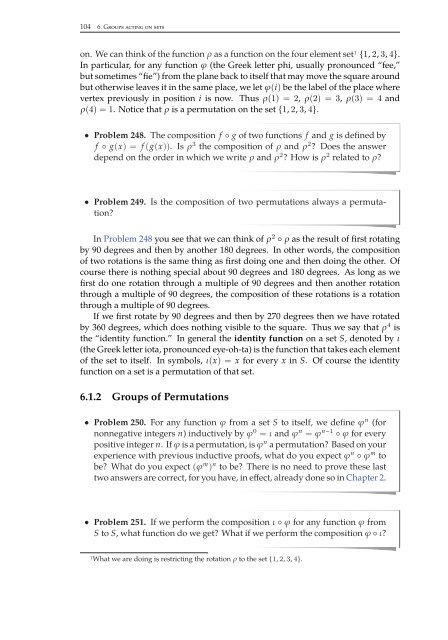Combinatorics Through Guided Discovery, 2004a
Combinatorics Through Guided Discovery, 2004a
Combinatorics Through Guided Discovery, 2004a
Create successful ePaper yourself
Turn your PDF publications into a flip-book with our unique Google optimized e-Paper software.
104 6. Groups acting on sets<br />
on. We can think of the function ρ as a function on the four element set1 {1, 2, 3, 4}.<br />
In particular, for any function ϕ (the Greek letter phi, usually pronounced “fee,”<br />
but sometimes “fie”) from the plane back to itself that may move the square around<br />
but otherwise leaves it in the same place, we let ϕ(i) be the label of the place where<br />
vertex previously in position i is now. Thus ρ(1) = 2, ρ(2) = 3, ρ(3) = 4 and<br />
ρ(4) = 1. Notice that ρ is a permutation on the set {1, 2, 3, 4}.<br />
• Problem 248. The composition f ◦ g of two functions f and g is defined by<br />
f ◦ g(x) = f (g(x)). Is ρ 3 the composition of ρ and ρ 2 ? Does the answer<br />
depend on the order in which we write ρ and ρ 2 ?Howisρ 2 related to ρ?<br />
• Problem 249. Is the composition of two permutations always a permutation?<br />
In Problem 248 you see that we can think of ρ 2 ◦ ρ as the result of first rotating<br />
by 90 degrees and then by another 180 degrees. In other words, the composition<br />
of two rotations is the same thing as first doing one and then doing the other. Of<br />
course there is nothing special about 90 degrees and 180 degrees. As long as we<br />
first do one rotation through a multiple of 90 degrees and then another rotation<br />
through a multiple of 90 degrees, the composition of these rotations is a rotation<br />
through a multiple of 90 degrees.<br />
If we first rotate by 90 degrees and then by 270 degrees then we have rotated<br />
by 360 degrees, which does nothing visible to the square. Thus we say that ρ 4 is<br />
the “identity function.” In general the identity function on a set S, denoted by ι<br />
(the Greek letter iota, pronounced eye-oh-ta) is the function that takes each element<br />
of the set to itself. In symbols, ι(x) =x for every x in S. Of course the identity<br />
function on a set is a permutation of that set.<br />
6.1.2 Groups of Permutations<br />
• Problem 250. For any function ϕ from a set S to itself, we define ϕ n (for<br />
nonnegative integers n) inductively by ϕ 0 = ι and ϕ n = ϕ n−1 ◦ ϕ for every<br />
positive integer n. Ifϕ is a permutation, is ϕ n a permutation? Based on your<br />
experience with previous inductive proofs, what do you expect ϕ n ◦ ϕ m to<br />
be? What do you expect (ϕ m ) n to be? There is no need to prove these last<br />
two answers are correct, for you have, in effect, already done so in Chapter 2.<br />
• Problem 251. If we perform the composition ι ◦ ϕ for any function ϕ from<br />
S to S, what function do we get? What if we perform the composition ϕ ◦ ι?<br />
1What we are doing is restricting the rotation ρ to the set {1, 2, 3, 4}.


















